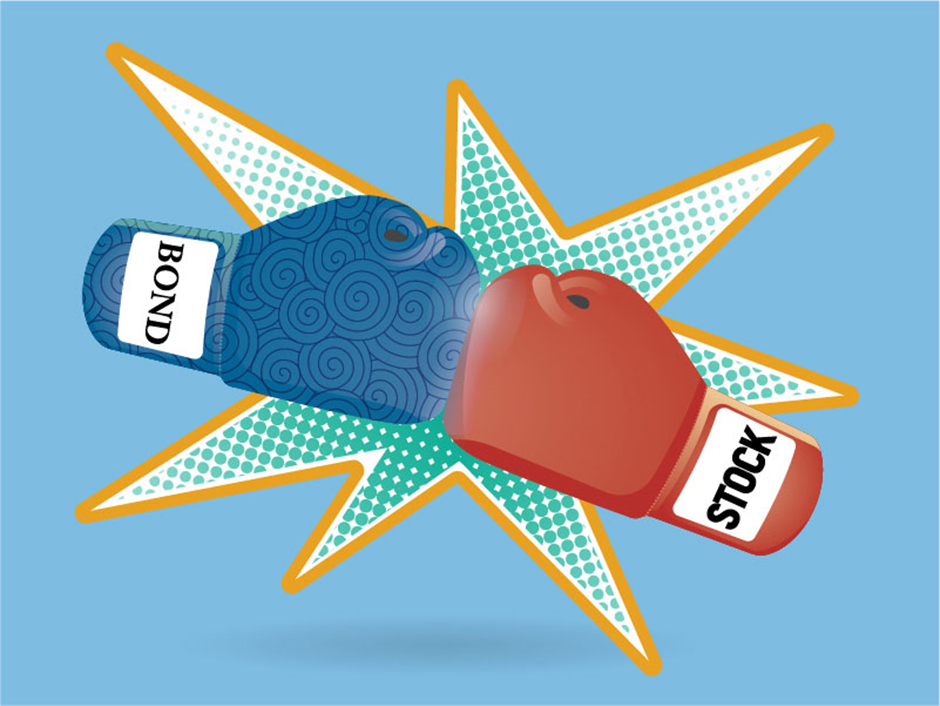If you choose to invest in a company, there are two routes available to you – equity (also known as shares) and debt (also known as bonds).
Shares are issued by firms, priced daily and listed on a stock exchange. Bonds, meanwhile, are effectively loans where the investor is the creditor. In return for lending money to the issuer, the investor receives an annual income as well as the ultimate repayment of the principal amount of the loan (unless the issuer defaults or the bond is purchased at a premium). Unlike shares, bonds can be issued by both companies and governments.
Depending on which route the investor takes, their rights, prospect of return and risk exposure will vary. Here, we explore the differences between shares and bonds and consider the most efficient ways to invest.

Shareholder versus bondholder rights
Let’s begin by looking at what rights we have. When investors buy shares in a company, they become one of many co-owners. This ownership brings both rights and responsibilities – significant shareholders can shape the company’s strategy and have the right to vote and veto corporate proposals. The upside of being a shareholder is the share price can rise in value, allowing investors to sell their holding and make a profit. But, of course, there’s no guarantee this will happen. Companies can also share their profits via dividend payments to shareholders; however such dividend payments are not mandatory.
The downside of buying shares is shareholders are not promised any economic return. Share prices can fall significantly, forcing investors to face the unwelcome choice between selling at a loss or waiting and hoping the shares recover. And if the worst happens, the company can go into liquidation, where shareholders are the last to be repaid. In this scenario, the investor could lose the entire investment.
Bondholders, by contrast, are in a more secure position if the company enters bankruptcy. That is because they fall under the category of creditors and so are repaid before shareholders. Moreover, even if the issuer defaults on its debts, there is most often a chance of recovery, albeit at a reduced level. An example of this is Argentina, which defaulted on its government bonds in 2001. Despite dealing with a severe economic crisis and despite what turned out to be a complicated legal issue, the country restructured its debts and, over several agreements, arranged to pay back its investors some portion of their principal amount.
What about risk?
When it comes to risk, there’s a general rule of thumb in investing. The riskier an investment is, the higher the potential to make a gain… but the chance of a loss is also higher. Shares are generally deemed riskier than bonds because swings in price are more severe. This is typically, but not universally, the case. Some bonds, issued by high-risk companies and governments, can be just as volatile as some shares. For example, so-called ‘junk’ or high yield bonds are those issued by companies that are more likely to default. This categorisation as ‘high yield’ is made by credit ratings agencies. Some government bonds – particularly those issued by certain emerging markets – are also considered high risk. Emerging markets are often in an earlier stage of development, and political uncertainties can also be present. To compensate for these risks, emerging market bonds generally offer higher yields.
Complementary assets
Bonds and shares can work well together, as part of a well-diversified portfolio. That is because they tend to have low correlations with each other, meaning they respond differently to changes in the economic cycle. (An exception to this is the global financial crisis when correlations between the two were higher.) If an economy is shrinking during a recession, interest rates are often cut, which tends to mean higher bond prices (and lower yields). This is a particularly good environment to invest in bonds. But in a recession, lower economic activity means consumers tighten their belts, and spend less on goods and services. A recession often presents a challenging period for firms (although we should note that ‘defensive’ shares, such as those issued by utility companies, hold up better). A well-chosen portfolio of both bonds and shares should stand an investor in good stead throughout the economic cycle. Of course, the two asset classes provide different benefits – bonds deliver a regular income, while shares offer the potential for capital growth.
Choosing the right investment
Before investing in either bonds or shares, it is important to ascertain your tolerance of risk. Do not invest what you cannot afford to lose, and it is a good idea to consult a professional financial adviser for guidance. And whatever your choice, it is worth considering a managed fund where your investment is pooled with other people’s and invested in a wide range of assets. This diversification means the effect of a default (in a bond fund) or share price fall (in an equity fund) can be minimised or offset by other better performing assets in the fund.
Want more to read and watch?
Explore our other fixed income articles
